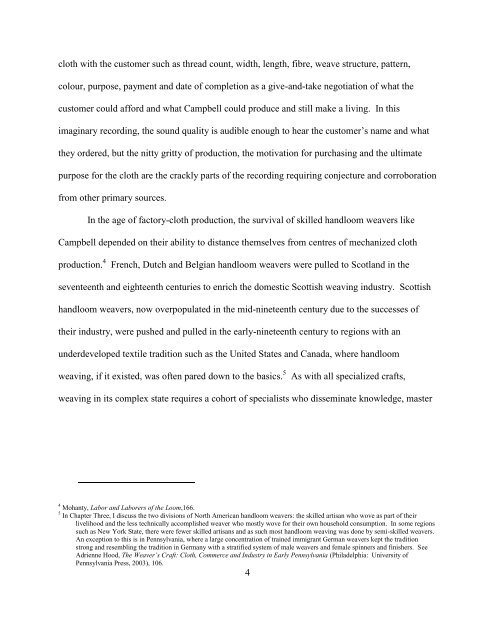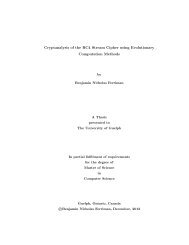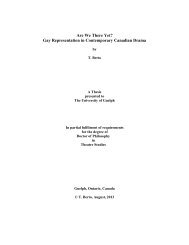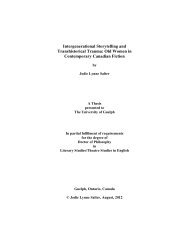University of Guelph thesis template - Atrium - University of Guelph
University of Guelph thesis template - Atrium - University of Guelph
University of Guelph thesis template - Atrium - University of Guelph
You also want an ePaper? Increase the reach of your titles
YUMPU automatically turns print PDFs into web optimized ePapers that Google loves.
cloth with the customer such as thread count, width, length, fibre, weave structure, pattern,<br />
colour, purpose, payment and date <strong>of</strong> completion as a give-and-take negotiation <strong>of</strong> what the<br />
customer could afford and what Campbell could produce and still make a living. In this<br />
imaginary recording, the sound quality is audible enough to hear the customer’s name and what<br />
they ordered, but the nitty gritty <strong>of</strong> production, the motivation for purchasing and the ultimate<br />
purpose for the cloth are the crackly parts <strong>of</strong> the recording requiring conjecture and corroboration<br />
from other primary sources.<br />
In the age <strong>of</strong> factory-cloth production, the survival <strong>of</strong> skilled handloom weavers like<br />
Campbell depended on their ability to distance themselves from centres <strong>of</strong> mechanized cloth<br />
production. 4<br />
French, Dutch and Belgian handloom weavers were pulled to Scotland in the<br />
seventeenth and eighteenth centuries to enrich the domestic Scottish weaving industry. Scottish<br />
handloom weavers, now overpopulated in the mid-nineteenth century due to the successes <strong>of</strong><br />
their industry, were pushed and pulled in the early-nineteenth century to regions with an<br />
underdeveloped textile tradition such as the United States and Canada, where handloom<br />
weaving, if it existed, was <strong>of</strong>ten pared down to the basics. 5<br />
As with all specialized crafts,<br />
weaving in its complex state requires a cohort <strong>of</strong> specialists who disseminate knowledge, master<br />
4 Mohanty, Labor and Laborers <strong>of</strong> the Loom,166.<br />
5 In Chapter Three, I discuss the two divisions <strong>of</strong> North American handloom weavers: the skilled artisan who wove as part <strong>of</strong> their<br />
livelihood and the less technically accomplished weaver who mostly wove for their own household consumption. In some regions<br />
such as New York State, there were fewer skilled artisans and as such most handloom weaving was done by semi-skilled weavers.<br />
An exception to this is in Pennsylvania, where a large concentration <strong>of</strong> trained immigrant German weavers kept the tradition<br />
strong and resembling the tradition in Germany with a stratified system <strong>of</strong> male weavers and female spinners and finishers. See<br />
Adrienne Hood, The Weaver’s Craft: Cloth, Commerce and Industry in Early Pennsylvania (Philadelphia: <strong>University</strong> <strong>of</strong><br />
Pennsylvania Press, 2003), 106.<br />
4
















